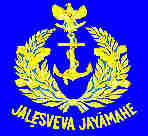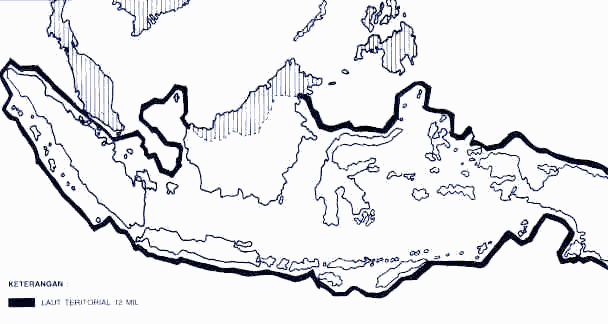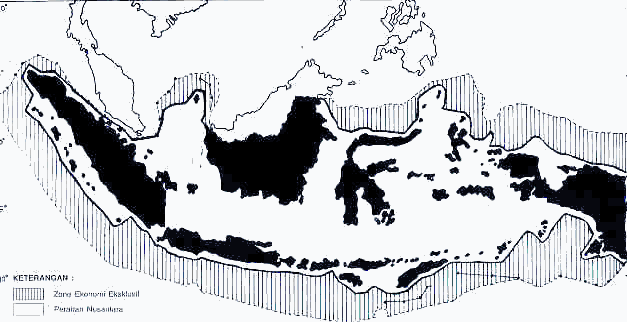





 The Indonesian Navy was established on 22 August 1945 following the Indonesian Proclamation of Independence. It was formed as the Agency of the People�s Security Sea Service (Badan Keamanan Rakyat-Laut or BKR), with only wooden ships, a few landing craft and weapons left by Japan. The BKR was developed by the alumni of the Sekolah Pelayaran Tinggi (Maritime College) and the Dutch Naval Academy (Koninjklijk Institut de Marine). Following the establishment of the Indonesian Armed Forces (ABRI) on 5 October 1945, BKR became known as Angkatan Laut Republik Indonesia (ALRI). The name ALRI was used until 1970, when it was changed to Tentara Nasional Indonesia Angkatan Laut (TNI-AL).
During the period of the independence war of 1945�1949, ALRI, with a minimum of forces, was able to conduct sea expeditions to various areas out of Java to establish naval bases, marine forces, and naval training schools. Apart from establishing naval forces out of Java, the objective of the expeditions was to expand the spirit of the proclamation, and increase exposure among other countries by breaking through naval blockades to obtain weapons, ammunition and medical supplies. These naval operations succeeded in encouraging resistance against the Dutch and establishing armed forces in Bali, South Kalimantan, and South Sulawesi.
With the recognition of Indonesian sovereignty by the Dutch under the Round Table Agreement on 2 November 1949, ALRI had the opportunity to consolidate its forces as a modern navy. This was followed by the delivery of ex-Koninklijke Marine (KM) ships, including corvettes and destroyers. On 5 December 1959, ALRI established a fleet to organise, operate and increase weapon materiel. The establishment of the fleet was a milestone for the development of ALRI.
The Indonesian Navy was established on 22 August 1945 following the Indonesian Proclamation of Independence. It was formed as the Agency of the People�s Security Sea Service (Badan Keamanan Rakyat-Laut or BKR), with only wooden ships, a few landing craft and weapons left by Japan. The BKR was developed by the alumni of the Sekolah Pelayaran Tinggi (Maritime College) and the Dutch Naval Academy (Koninjklijk Institut de Marine). Following the establishment of the Indonesian Armed Forces (ABRI) on 5 October 1945, BKR became known as Angkatan Laut Republik Indonesia (ALRI). The name ALRI was used until 1970, when it was changed to Tentara Nasional Indonesia Angkatan Laut (TNI-AL).
During the period of the independence war of 1945�1949, ALRI, with a minimum of forces, was able to conduct sea expeditions to various areas out of Java to establish naval bases, marine forces, and naval training schools. Apart from establishing naval forces out of Java, the objective of the expeditions was to expand the spirit of the proclamation, and increase exposure among other countries by breaking through naval blockades to obtain weapons, ammunition and medical supplies. These naval operations succeeded in encouraging resistance against the Dutch and establishing armed forces in Bali, South Kalimantan, and South Sulawesi.
With the recognition of Indonesian sovereignty by the Dutch under the Round Table Agreement on 2 November 1949, ALRI had the opportunity to consolidate its forces as a modern navy. This was followed by the delivery of ex-Koninklijke Marine (KM) ships, including corvettes and destroyers. On 5 December 1959, ALRI established a fleet to organise, operate and increase weapon materiel. The establishment of the fleet was a milestone for the development of ALRI.
The Navy was initially stocked primarily with craft once operated by European or the Australian navies. Beginning in 1959, the navy began to acquire a large number of craft from the Soviet Union and East European nations. In the aftermath of the abortive 1965 coup, however, the navy suffered a decline in influence within the armed forces and the nation because of suspected involvement in the coup attempt (particularly by the marine corps) and because of its small size in comparison with the army. A large portion of its vessels of Soviet or East European origin were quickly rendered non-operational owing to a lack of spare parts and maintenance expertise.
During the period of confrontation, the Indonesian naval capability increased in quality and quantity. The fleet was strengthened by acquisitions from Russia including cruisers, destroyers, frigates, fast attack missile craft and submarines. The Marine Corps was also reinforced by armoured and amphibious vehicles, and naval aviation with ASW helicopters and bombers (IL28). In 1970, after the severing of diplomatic ties with Russia, which created problems maintaining the Russian ships, TNI-AL obtained an ex-US Navy destroyer escort, and an ex-RAN fast attack craft (K-16M class) to replace the ex-Russian vessels. Until the late 1970s, the only major replacements were four frigates acquired from the United States Navy in 1974. Since that time, the navy embarked on an upgrading program designed to develop a balanced fleet suited to operations in archipelagic waters. Over the 1978-92 period, it purchased submarines from the Federal Republic of Germany (West Germany), light frigates from the Netherlands and Britain, and fast attack craft from the Republic of Korea (South Korea). In 1992 the Indonesian government announced plans to acquire thirty-nine used ships of various types from the navy of the former German Democratic Republic (East Germany). The navy produced numerous small coastal craft in national shipyards as well. As of 1992, the fleet was composed of more than sixty ships and numerous smaller vessels. The national and global situation at the beginning of the 1980s gave new impetus to the development of TNI-AL and the promulgation of the Indonesian EEZ (Economic Exclusive Zone) brought with it new challenges and demands. The small, effective and efficient force was required to develop into a professional, effective and modern navy. In order to conduct its primary role as a naval force, TNI-AL initiated a development and management program, including the maintenance of forces through an integrated fleet weapons system (SSAT). The elements of SSAT are ships, as a basic weapon system, aircraft, the Marine Corps and naval bases. The SSAT is a combination of strategic weapons with logistic support reflecting a strong navy. The navy's mission was to act as a territorial force responsible for the patrol of Indonesia's immense coastline. The vast majority of operational ships were stationed at the main naval base at Surabaya, Jawa Timur Province. Whereas the 1970s saw an increase in the fleet's ship inventory, the 1980s witnessed a major effort to improve the navy's armament posture through the purchase of the Harpoon weapons system and the MK-46 torpedo. The 1990s were expected to be largely a period of consolidation and training. The minimum maritime capability to ensure national security is sea denial. Based on that capability, modernisation was achieved through the procurement of modern, high technology naval ships from a variety of countries, including Holland (Fatahilah class corvettes, � Van Spijk� frigates, and Tripartite class minehunters), Yugoslavia (destroyer escort training ship KRI Kihajar Dewantara-364; Korea, �Patrol Ship Killer�Missiles� (PSK) and Tacoma class landing ship tank), the United Kingdom (ex-Tribal class) and Germany (209 class submarine). The national shipyard, PT PAL, also produced FPB-57 class patrol boats for TNI-AL. Structurally, the navy comprised the headquarters staff at Jakarta under the overall command of the navy chief of staff, two fleet commands (the Eastern Fleet in Surabaya, the Western Fleet in Jakarta), the marine corps, a small air arm, and a military sealift command. There were about 44,000 uniformed personnel serving in the navy in 1992, including about 13,000 marines. The marines were organized into two brigades, one in Jakarta and the other in Surabaya, and were equipped with light tanks, armored personnel carriers, and antiaircraft guns. Some of the marine elements were believed occasionally to be attached to KOSTRAD in operational missions.![[PDF]](id05_04c.gif)
The 1985 reorganization of the military made significant changes in the former territorial commands of the navy, which were eliminated from the structure altogether, with the service represented on the KODAM staff by a senior liaison officer. The navy territorial commands were replaced by Eastern Fleet and Western Fleet--Armadas. The Navy fleets split the Western Fleet corresponding to KODAMs I through IV and VI and with the Eastern Fleet corresponding to KODAM V and KODAMs VII through IX.
The navy has maintained a small air arm since 1958. Headquartered at Surabaya, its personnel numbered some 1,000 in the early 1990s. It was equipped primarily for naval reconnaissance and coastal patrol duties, flying three squadrons of light airplanes, as well as several transports and helicopters. Naval aviation was supplemented with Nomads (N-22) from Australia, Wasp ASW helicopters from the UK, and products of IPTN such as Cassa, Super Puma and BO-105. The Marine Corps also received amphibious vehicles from France. More recently, TNI-AL obtained 39 ex-East German naval ships. In order to enhance the capability of logistic support, maintenance and administration for the unit operation, TNI-AL established five main bases with several subordinate bases, a maintenance facility, and a naval aviation base.The military sealift command coordinated the navy's logistical support systems.
In the early 1990s, naval warships generally were not deployed to a particular region but were grouped in mobile flotillas, to be dispatched where needed. Usually these included eastern, western, and central groups, but activity was most often concentrated in the west in the vicinity of the bases at Belawan in Sumatera Utara Province, Tanjungpinang in Riau Province, near Singapore; and in the east near the base at Manado in Sulawesi Utara Province. This pattern was in keeping with the major missions envisioned for the navy in the 1990s. One mission concerned patrolling the strategic straits through which foreign ships enter and exit the Indian Ocean, particularly the Strait of Malacca. The other mission centered on halting smuggling and illegal fishing, considered to be problems particularly in the areas near the Natuna Islands and in the seas between Kalimantan and Irian Jaya. In support of the second mission, the navy announced plans to construct a number of limited-role bases in isolated areas in the eastern and western sections of the national territory. Patrol activity also increased in connection with the flow of refugees from Southeast Asia, particularly in the area near the Natuna Islands. The naval shipyard--P.T. PAL--was turned over to the civilian government, but it, along with other facilities in Surabaya, continued to be the navy's primary training, repair, and industrial center. Since P.T. PAL's transfer to civilian control and designation as a state enterprise, it developed and implemented improvements for a management and technical upgrade of the shipyard to support the Indonesian fleet as well as to conduct commercial repairs for foreign navies. Small craft construction facilities were located at shipyards in Jakarta, Manokwari, Irian Jaya Province; Semarang, Jawa Tengah Province; and Ambon, Maluku Province. Because of severe budgetary constraints imposed by the national government, no near-term acquisition of major new weapons systems was planned by the navy in the early 1990s. Continual overhaul of foreign-origin ships was perceived as the primary method to retain an operational fleet. Future projects included plans for an Indonesian-designed frigate and construction of a major naval base at Ratai Bay, Lampung Province. The immense costs involved, however, made achievement of these ambitious goals unlikely. When independence was proclaimed and sovereignty gained, Indonesia had to enact laws to govern the seas in accordance with the geographic structure of an archipelagic state. This, however, did not mean that the country would bar international passage. The laws were necessary instruments for the unity and national resilience of the country, with a territory that embraces all the islands, the islets and the seas in between.In view of the country's susceptibility to foreign intervention from the sea and for domestic security reasons, on December 13, 1957, the Indonesian Government issued a declaration on the territorial waters of the Republic. It stated that all the waters surrounding and between the islands in the territory came within Indonesia's sovereignty. It also determined that the country's territorial water limit was 12 miles, measured from a straight baseline drawn from the outermost points of the islands.
In the past, archipelagic states like Indonesia have unilaterally determined their 200-mile-Exclusive Economic Zones. Today such economic zones are confirmed by the International Convention on the Law of the Sea, which was ratified by the Indonesian Government on October 18, 1983, by Act No. 5 of the same year. This is the legal basis of the Indonesian-Exclusive Economic Zone.


